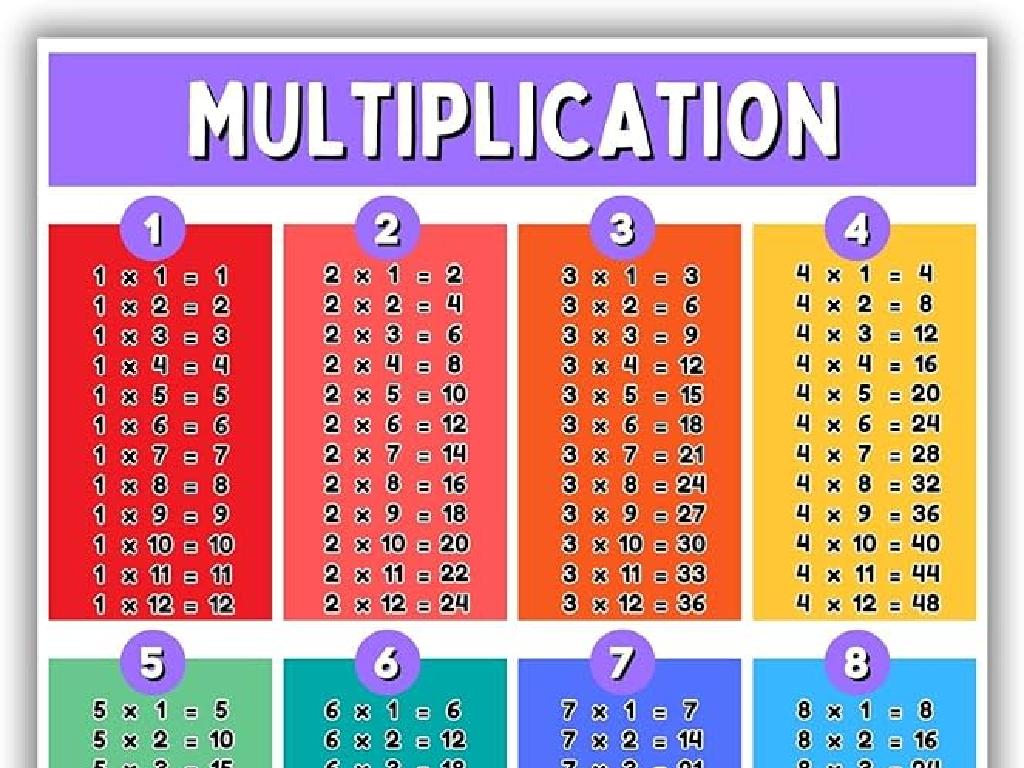How Does Matter Move In Food Chains?
Subject: Science
Grade: Sixth grade
Topic: Ecological Interactions
Please LOG IN to download the presentation. Access is available to registered users only.
View More Content
Ecological Interactions: Food Chains
– Explore our environment
– What are food chains?
– A sequence of who eats whom in the wild
– Energy flow in nature
– Energy moves from plants to herbivores to carnivores
– Role of organisms in energy transfer
– Producers, consumers, and decomposers work together
|
This slide introduces students to the concept of ecological interactions with a focus on food chains. Begin by discussing the importance of understanding our environment and the interdependence of organisms within it. Explain food chains as a model that illustrates the flow of energy from one organism to another. Highlight how energy originates from the sun, is utilized by plants (producers), and then transferred to herbivores (primary consumers) and carnivores (secondary consumers). Emphasize the role of each organism in the chain, including decomposers, which recycle nutrients back into the ecosystem. Use examples like a simple grassland food chain to illustrate these points. Encourage students to think about local food chains and the roles different organisms play in their own environment.
Matter in Food Chains
– Matter: Everything around us
– Atoms & molecules: Building blocks
– Atoms are the smallest units, molecules are groups of atoms.
– States of matter: Solid, liquid, gas
– Matter exists in different forms; these are observable in our environment.
– Matter’s role in food chains
– Matter is transferred through organisms in a food chain.
|
This slide introduces the concept of matter as it relates to food chains in an ecosystem. Begin by explaining that matter is anything that has mass and takes up space, encompassing everything we can touch and see. Clarify that atoms are the smallest units of matter, while molecules are combinations of atoms bonded together. Discuss the three states of matter solid, liquid, and gas and how they can change from one state to another. Emphasize the importance of understanding matter’s different states when considering how energy and nutrients move through a food chain. Illustrate how matter cycles through an ecosystem as plants absorb nutrients from the soil, animals eat plants, and predators eat other animals, with each step involving the transfer of matter.
Food Chains: The Basics
– Roles: Producers, Consumers, Decomposers
– Producers make food, consumers eat it, decomposers break down dead matter.
– Organisms’ Interdependence
– Every organism relies on others for survival, forming a complex web.
– Energy Flow in Food Chains
– Energy starts with the sun, moves to producers, then consumers, and finally decomposers.
– Matter Cycling in Ecosystems
– Matter is recycled, ensuring nutrients are available for producers.
|
This slide introduces the basic components of food chains and their roles within an ecosystem. Producers (like plants) create their own food using sunlight, consumers (animals) eat the producers or other consumers, and decomposers (fungi and bacteria) break down dead organisms, returning nutrients to the soil. Highlight the dependency of each organism on others for energy and nutrients, creating a balanced ecosystem. Explain how energy flows from the sun through the different levels of the food chain and how matter is recycled by decomposers, making it available again for producers. Use examples like a simple grassland food chain to illustrate these concepts. Encourage students to think about local food chains and the roles of different organisms within them.
Matter Movement in Food Chains
– Matter cycles in ecosystems
– Matter is recycled within and between ecosystems through biogeochemical cycles.
– Producers’ role in matter flow
– Producers like plants convert sunlight into energy, starting the matter flow.
– Consumers’ contribution
– Consumers like animals eat plants or other animals, moving matter up the chain.
– Energy transfer among organisms
– As organisms interact, matter and energy are transferred through the food chain.
|
This slide introduces the concept of matter movement within food chains, which is a fundamental aspect of ecological interactions. Students should understand that matter is not created or destroyed but is cycled through ecosystems. Producers, such as plants, play a key role by converting sunlight into energy through photosynthesis, beginning the flow of matter. Consumers, including herbivores, carnivores, and omnivores, contribute by eating producers or other consumers, thus transferring matter and energy up the food chain. Decomposers also play a crucial role by breaking down dead organisms, returning matter to the soil for use by producers. Emphasize the interconnectedness of all organisms within an ecosystem and how matter moves through each trophic level. Encourage students to think of examples of producers and consumers in local ecosystems.
Decomposers: Nature’s Recyclers
– Decomposers break down dead matter
– Organisms like fungi and bacteria decompose dead plants and animals
– They return nutrients to the soil
– Nutrients from decayed matter enrich the soil, aiding plant growth
– Essential for ecosystem balance
– They help maintain equilibrium by recycling matter
– Decomposers’ role in food chains
– They close the loop by breaking down producers and consumers
|
Decomposers play a crucial role in the ecosystem by breaking down dead organisms and waste products. This process of decomposition is vital as it returns essential nutrients to the soil, which plants use to grow. Without decomposers, ecosystems would be overwhelmed with dead matter, and the cycle of nutrients would be disrupted. In the context of food chains, decomposers are the final link that ensures the flow of matter continues. They provide a clear example of how matter moves and is recycled in ecological systems. Encourage students to think of decomposers as nature’s cleanup crew and discuss their importance in maintaining the health of our planet.
Matter Movement in Food Chains
– Forest ecosystem case study
– How do trees, plants, and animals share matter?
– Pond food chain matter tracking
– Observe how pond organisms like algae and fish cycle matter.
– Grassland food web interaction
– Role-play as sun, grass, rabbits, and foxes to see matter flow.
– Understanding matter transfer
|
This slide aims to illustrate the concept of matter movement within different ecosystems. Start with a case study of a forest ecosystem, discussing how matter moves between trees, plants, and animals through processes like photosynthesis and decomposition. Then, track how matter is cycled in a pond food chain, from algae through to the fish that eat them. An interactive example with a grassland food web can be a role-playing activity where students act out the roles of producers and consumers to visualize the transfer of matter. Emphasize that in all ecosystems, matter is neither created nor destroyed; it is simply transferred from one organism to another, forming a continuous cycle that is essential for life.
Human Impact on Matter Movement in Food Chains
– Effects of pollution on food chains
– Pollutants can alter habitats and affect the energy flow.
– Conservation efforts and food chains
– Initiatives like habitat restoration help maintain balance.
– Our role in protecting food chains
– Simple actions at home can reduce negative impacts.
– Class activity: brainstorming session
|
This slide aims to educate students on the human-induced changes to matter movement within food chains, primarily focusing on pollution and conservation. Discuss how pollutants can disrupt the delicate balance of ecosystems, leading to consequences like the biomagnification of toxins. Highlight conservation efforts such as wildlife protection laws and habitat restoration projects. Encourage students to think about how their actions, like recycling and conserving water, can positively affect local food chains. For the class activity, facilitate a brainstorming session where students come up with ideas on how to reduce their environmental footprint. Possible activities include creating posters on conservation, starting a recycling program, or planting a garden to support local wildlife.
Class Activity: Build Your Own Food Chain
– Create a food chain using organisms
– Identify producers, consumers, decomposers
– Producers make food, consumers eat it, decomposers break down waste
– Discuss matter movement in the chain
– Matter cycles from producers to consumers to decomposers
– Reflect on the importance of each role
|
This activity is designed to help students understand the flow of matter within an ecosystem’s food chain. Provide a set of organism cards that include various producers (plants), consumers (herbivores, carnivores), and decomposers (fungi, bacteria). Students will arrange these into a food chain, identifying the role of each organism. Facilitate a discussion on how matter, such as nutrients and energy, moves through the chain. For example, plants (producers) convert sunlight into energy, herbivores (consumers) eat the plants, carnivores eat the herbivores, and decomposers break down dead organisms, returning nutrients to the soil for plants to use. Encourage students to think about how each part of the food chain is connected and why each is crucial for the ecosystem’s health. Possible variations of the activity could include creating food webs, discussing energy pyramids, or exploring the impact of removing an organism from the chain.
Matter Movement in Food Chains: Recap
– Recap: Matter in Food Chains
Matter cycles through food chains from producers to consumers.
– Ecosystem Balance
A stable ecosystem relies on balanced food chains.
– Engage in Q&A Session
– Reflect on Learning
Think about how energy flows differently than matter.
|
This slide aims to summarize the key points about how matter moves through food chains and the importance of balance in ecosystems. Begin by recapping the journey of matter, starting with producers (like plants) and moving up through consumers (like animals). Emphasize the cyclical nature of this process and how matter is conserved within an ecosystem. Discuss the concept of balance and how each organism plays a role in maintaining the health of its environment. The Q&A session will allow students to clarify any doubts and solidify their understanding. Encourage them to ask questions about anything from the presentation. Finally, prompt students to reflect on what they’ve learned about the difference between the flow of energy and the cycling of matter in food chains.






